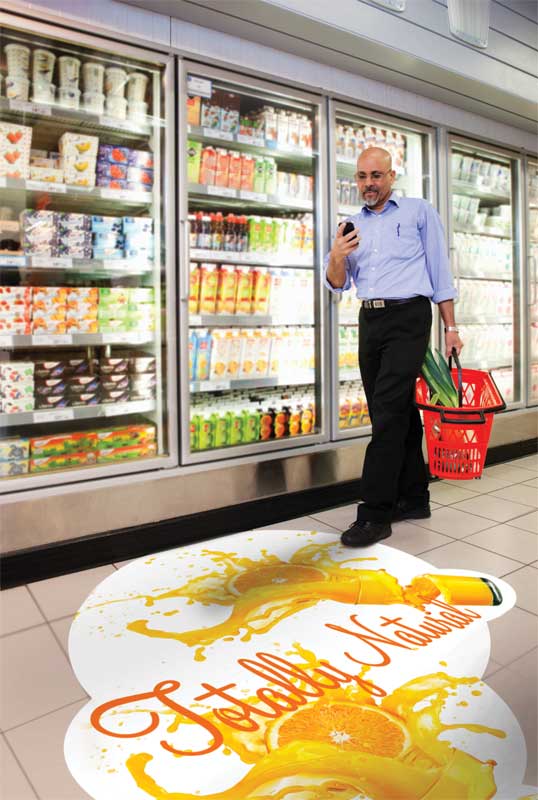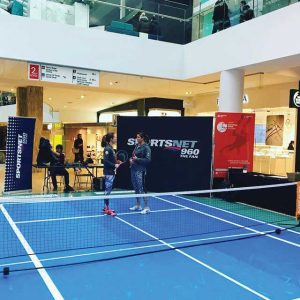Thinking Outside the Box with Eye-catching Floor Graphics
by | 8 March 2019 11:09 am
 [1]
[1]Floor decals can be added to a list of must-have advertising graphics, from exterior signage to point-of-sale (POS) to shelf-edge displays.
By Steve Yarbrough
When on an airplane, passengers are asked to pay attention to the pre-flight safety demonstration, which includes the location of the emergency exits—with illuminated pathways showing the way down the aisle. This demonstrates just how important floor-level signage is for safety and wayfinding in public environments, but floor graphics can also be used for stunning interior decor in hotels and restaurants, temporary displays for events, or as incredibly effective advertising methods in exhibition venues and retail spaces.
In fact, retailers are becoming increasingly aware that their potential customers’ attention is being drawn away from the wares on the shelves and towards their phones. A phone is an essential item for many shoppers, whether to compare prices, check a store’s location, download coupons, or find a place to stop for lunch. As a result, messages of all kinds need to be displayed where phone-users can see them—on the ground. Floor decals can also be added to a list of must-have advertising graphics, from exterior signage to point-of-sale (POS) to shelf-edge displays. It is all part of achieving a complete brand identity, delivering a well-rounded shopping experience, and managing the customer’s journey through the door and towards the cash register.
The impact of floor graphics
The way-marking function of floor graphics is also ideal for keeping foot traffic moving in museums, theme parks, hospitals, transport hubs, educational facilities, city centres, and other busy environments. Floor graphics are a common sight at trade shows and exhibitions, too. In most cases, there is plenty of floor space to fill with directional signage as well as sponsors’ logos, brand colours, advertising, social media prompts, and lots more—a mass of information required for a short time.
Indeed, floor decals are becoming a more common and impactful sight as short-term displays or decorations for all types of events. For example, these decals can be used for a school graduation to decorate the venue’s aisles with a graphic that has photos of the graduates in their caps and gowns with an image of a red carpet layered behind it. This image can be printed onto specialist floor media and affixed to the concrete. Using floor graphics in this manner can be an inexpensive way to add a personal touch to any event. In fact, in this example, it can even be cheaper than renting a carpet. Further, the graphics will not leave any marks on the floor when removed.
This type of application can work in a variety of large events where an aisle or clear floor space can benefit from personalization for a one-time occasion.
 [2]
[2]Floor graphics work in a variety of large events where clear floor space can benefit from personalization for a one-time occasion.
Alternatively, floor graphics can be incredibly effective in transforming the purpose of a space, for instance turning a shopping mall into a recreation destination. Recently, an area of the Core Shopping Centre in Calgary, Alta., was turned into a tennis court using floor graphics that were designed, printed, and installed by Print Three (also in Calgary) as part of a 10-day promotional campaign for the Calgary National Bank Challenger. This attracted families to the space to play a few sets and, as a result, more people wanted to visit and stay longer.
Easy as one-two-three
In many of these applications, speed is of the essence in regards to installation and removal. Some environments may be open 24 hours a day, or have heavy foot traffic during core hours; therefore, it is essential to choose media for floor displays that is easy to install and remove in the most time- and cost-effective manner possible.
Many businesses may be tempted to choose a multi-purpose display material for floor graphics but, while some advertising media is designed to be used on a variety of surfaces, it is a wise move to invest in a material specifically designed to affix to common flooring surfaces. These will feature a specially developed adhesive that will enable the printed display to be installed and possibly even repositioned quickly and easily, but can also be removed cleanly without leaving adhesive behind.
Some floor graphic products have been designed to enable even non-professionals to install them. These media may feature air-egress style adhesives, which let the trapped air escape through small channels, eliminating the need for special tools during installation.
“Floor graphic products have different degrees of longevity, dependent on whether the application is for indoor or outdoor use, its intended floor surface, and the traffic it is likely to encounter.”
 [3]
[3]An area of the Core Shopping Centre in Calgary, Alta., was turned into a tennis court using floor graphics that were designed, printed, and installed by Print Three (also in Calgary) as part of a 10-day promotional campaign for the Calgary National Bank Challenger.
In addition to choosing specialist films for floor graphics projects, it is important to know there are a variety of products to choose from within this market. Different products have various degrees of longevity, dependent on whether the application is for indoor or outdoor use, its intended floor surface, and the traffic it is likely to encounter. For instance, the tennis court project described above demonstrated how choosing a professional floor graphics media that is compatible with the floor type can pay off enormously. Despite being designed as a playing surface and expected to suffer numerous rips and scuffs, no part of the display had to be repaired or replaced over the 10 days—yet it was removed cleanly in approximately 20 minutes at the end of the campaign. In short, no one wants to use a material that requires extra labour or supplies on installation or removal; therefore, choosing the right product from the outset will pay off in the long-run.
Play it safe
Floor graphics have a unique—and essential—dimension to consider compared to other types of fixed displays: safety for those who walk across them. In any environment floor decals should not present even a minimal slip and/or trip hazard. Therefore, only floor graphics media that are officially certified with an anti-slip rating for safety should be considered. Some will require an anti-slip laminate while others are direct-to-print, with an anti-slip surface manufactured within the material; however, either way, this rating should be clearly advertised. In regards to preventing a tripping risk, floor displays must be securely affixed to the surface to stop the edges from coming loose. Again, this comes down to the adhesive used.
A floor decal’s durability and, therefore, safety is also dependent on its compatibility with the surface to which it is applied. As mentioned, buying a product specifically designed for floors is an investment in terms of the ease of installation, removal, and longevity, but the actual type of floor surface must be considered, too. Many floor films are designed for use with all common types of hard flooring such as ceramic tiles, polyvinyl chloride (PVC) flooring, and sealed wood and concrete. A second specialized floor media for use with carpets may be needed, however. In every case, the floor films should adhere properly to the surface and, when finished, be able to be removed without leaving a trace.
Common to all display graphics, however, is the necessity for fire safety. From shopping malls to hospitals, the media used in floor graphics must have a fire rating that ensures it meets the strict requirements of these busy public spaces. The specialty graphics fire rating should be listed on the products’ technical specifications. Floor graphics media that do meet fire and other safety restrictions are, of course, ideal for marking evacuation routes and procedures; however, these signs must be properly maintained and replaced if they show any sign of damage.
 [4]
[4]Despite being designed as a playing surface and expected to suffer numerous rips and scuffs, no part of the display had to be repaired or replaced over the 10 days.
Keeping up appearances
Wear and tear is, obviously, bad for any type of display. The design and colour of floor graphics, which will experience the impact of people walking and tracking debris across the surface, may suffer the worst out of any multi-faceted advertising campaign. For this reason, floor graphics are essentially short-term—or frequently replaced with fresh prints—but must be durable enough to last the required period of time. Installers and suppliers should, therefore, conduct their own research and purchase floor media specified as being compatible not only with their printing technology, but also their client’s needs.
Independent tests should ascertain more exact information on the material and ink’s longevity and durability prior to the installation of the floor graphic. Some materials, inks, and printing technologies—and combinations of these—will endure scuffs, dirt, chemical cleaning, and ultraviolet (UV) light better than others so it is important to know what to expect before installing the floor graphics.
The key point to remember for any business considering floor graphics—including printers, installers, and customers—is that cheaper products do not always save money. In fact, they can create additional costs due to print failures, installation problems, and complications during removal. Extra time wasted on reprints or removing adhesive left behind after the campaign is over incur additional costs that need to be factored into an installer’s product-buying decisions. The product should be specifically designed to be compatible with the floor surface, the expected conditions, the printer and the ink, and the intended longevity and durability.
Further, the product should also be supported by the dealer or manufacturer. If the wrong materials are purchased, a sign installer may kick themselves later for making an incorrect decision of using an inferior product and leaving themselves in a sticky situation.
With almost 10 years of experience with Drytac, Steve Yarbrough currently serves as a product support specialist. With his excellent technical knowledge and thorough understanding of the market, Yarborough provides Drytac’s customers sound advice on both products and applications. His background in art and graphic design also allows him to offer insight into the graphic and print industry. He can be reached via e-mail at steveyarbrough@drytac.com[5].
- [Image]: https://www.signmedia.ca/wp-content/uploads/2019/03/2-floor-graphic-1.jpg
- [Image]: https://www.signmedia.ca/wp-content/uploads/2019/03/42363671_334857903935947_9041384858985850652_n.jpg
- [Image]: https://www.signmedia.ca/wp-content/uploads/2019/03/5-floor-graphic.jpg
- [Image]: https://www.signmedia.ca/wp-content/uploads/2019/03/43257069_272538016923266_5657986689266055628_n.jpg
- steveyarbrough@drytac.com: mailto:steveyarbrough@drytac.com
Source URL: https://www.signmedia.ca/thinking-outside-the-box-with-eye-catching-floor-graphics/